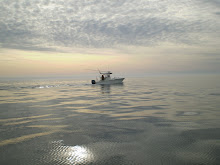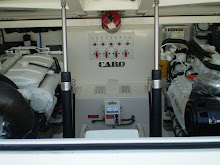
By Jim Field
Well, the million dollar question we're all wondering about is whether the oil slick will travel around the tip of Florida and head North up the Atlantic coastline. How devastating would that be? Answer: very devastating. Earlier this month, on June 4, the WSJournal published an article about the results from supercomputer studies performed by Los Alamos government scientists suggests that the odds of this nightmare happening are "very likely." Wow. More specifically, they are saying there's a "high degree of certainty" that oil will enter the Atlantic within the next six months. What really caught my eye is their expectation that if the oil does indeed enter the "powerful" Gulf Stream, it will move North at a rate of 100 miles a day. [Note: if you want to see a very cool video of the predictive computer model in motion, go to the bottom of this post and click on the word "here".]
The map accompanying the article below

 Model Suggests Slick Could Zoom Up East Coast
Model Suggests Slick Could Zoom Up East Coast By ROBERT LEE HOTZ
June 4, 2010
New supercomputer studies suggest it is "very likely" ocean currents will carry oil from the Deepwater Horizon spill in the Gulf of Mexico around the tip of Florida and thousands of miles up the U.S. East Coast this summer, researchers announced Thursday.
"It is truly a simulation, not a prediction," said Terry Wallace, principal associate director for science, technology and engineering at the Los Alamos National Laboratory in New Mexico, which collaborated on the project. "But it shows that when you inject something into the Gulf, it is likely to have much larger consequences."
So far the oil has been confined by strong eddies, but that is almost certainly a temporary respite, say oceanographers.
Researchers from the National Center for Atmospheric Research in Boulder, Colo., and the Los Alamos laboratory used a $100 million computer model of the world's ocean-circulation patterns to assess how currents could sweep the oil out of the Gulf.
The simulations show a strong Loop Current almost inevitably will pull the oil into the powerful Gulf Stream. It would then travel up the Atlantic coast at a speed of about 100 miles a day.
"From these simulations we can say with a high degree of certainty that it is very likely sometime in the next six months that oil from this spill will get into the Atlantic," said oceanographer Synte Peacock of the NCAR, who is running the project. "We can say that when it happens, it will be fast, much faster than anything we have seen so far," she said.
Authorities were already tracking an oil slick a bit more than five miles off the coast of Pensacola, Fla., Thursday. Some branches of the spill could start hitting beaches in the western Florida Panhandle on Friday and Saturday, according to the latest projections by the National Oceanic and Atmospheric Administration.
The Coast Guard said on its website that it had received several reports of an oily substance and tar balls along the Florida Keys. Samples have been sent to a laboratory for testing.
To make their longer-term calculations, Dr. Peacock and her colleagues studied six different oil-spill scenarios.
They injected the electronic equivalent of a dye tracer into the currents of a detailed global ocean-circulation model. To analyze its movements, the oceanographers had divided the seas into tens of millions of interacting segments of computer code.
The simulation takes into account factors such as wind speed, current patterns, temperatures and past weather patterns.
Each simulation took 24 hours to complete, running on several of the world's fastest supercomputers at the New Mexico Computer Applications Center and the Oak Ridge National laboratory.
So far, the studies haven't been reviewed by independent scientists or published.
The simulations aren't precise enough to make predictions about when and where oil might make landfall. The researchers said they couldn't predict the actual behavior of the oil spill because the physics governing the interactions between oil and water are too complicated to model accurately. The injection of dispersants to break up the oil spill also complicates the behavior of the oil in ways that no one can predict.
"In terms of the oil spill," Dr. Peacock said, "this model gives you a big-picture response, not the fine details."
If you want to see a live video of the model click here









No comments:
Post a Comment